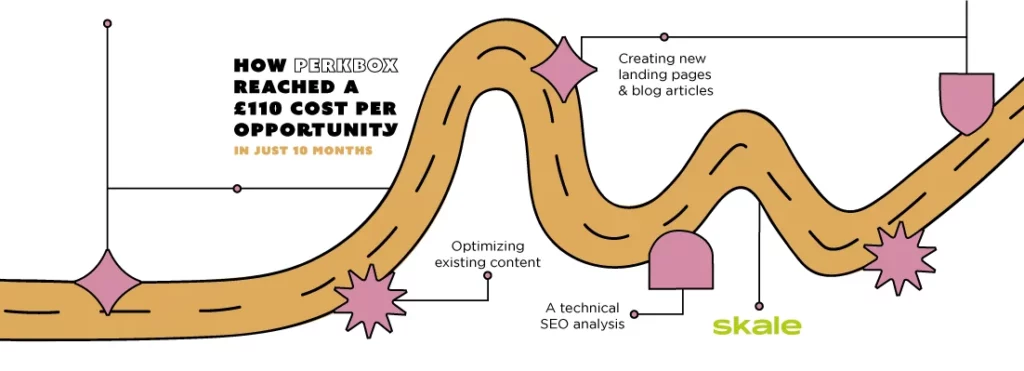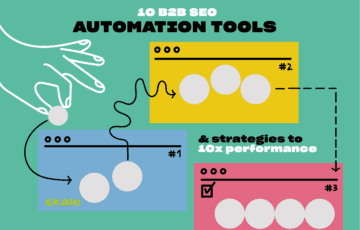
The Power of Partnership: 7 Benefits of Hiring a B2B SEO Agency
These benefits of hiring a B2B SEO agency illustrate why outsourcing your content can help you to drive new revenue for your business.


Level up your SEO strategy with Skale
See where Skale’s SEO experts can take your MRR when you get in touch.
Schedule a callSearch engine optimization is what will allow your business to go from having a great product to one that has a great product and customers finding out about it.
Being on the first page of Search Engines Result Pages (SERPs) is key for making your business visible. In fact, the top three results of Google get 54.4% of all clicks–exactly where our client case studies end up.
However, it’s easier said than done.
To have a strong SEO strategy you need to focus on three elements:
This means there are many moving parts and in order to have a successful SEO strategy you’ll need to know what you’re doing–and the latest trends.
We at Skale have a team of experts that are more than prepared and ready to up our clients’ SEO game in a way that helps them see real return of investment. Let’s look at some of our own SEO case studies. They’ll help you see how we got the results that we got–and how you can do the same!
Slite is a Series A collaboration software platform that has raised more than $15.4m. Big names like Notion, Coda, and Slab are its biggest competitors.
After securing an $11m Series A investment they wanted to make SEO their scalable acquisition channel.
What we did:

Start winning with link-building
Work with Skale to build MRR with a winning link-building team
Schedule a callThe first thing to do in order to create a solid B2B SEO strategy is to make sure you know what you’re working with. This means you need to do a full site and content audit.
The best way to do a thorough audit is to use B2B SEO tools paired with the right knowledge and understanding of what to look for–ahem, an agency with a team of experts can be exactly what you need! SEO tools will help you better analyze what your keyword strategy and blog pages are doing for you in terms of organic traffic. You’ll also see what your landing page and referring domains are doing for you.
It’s also important to perform a technical SEO audit to make sure your content and website have all the technical aspects in place: site speed, crawlability, schema markup, etc. Additionally, don’t forget to do a competitive analysis. By doing a competitor analysis, you’ll see what’s working for your rivals, and what content gaps there are that you can seize.
Nathan Latka is a serial entrepreneur, podcast host, and best-selling author. He helps SaaS founders and investors by providing insightful data on SaaS companies by region, industry, and more.
Nathan Latka wanted to compete against company insights databases such as Owler and Crunchbase., as well as attract a strong SaaS audience to his website. Among other tactics, this meant using SaaS-related keywords, which are extremely competitive.
What we did:
One of the best ways to increase organic traffic, and what we did with Nathan Latka, was focusing on on-page optimization.
Keywords are an important on-page factor. An important element of on-page SEO is keywords. In order to really get the most out of your keywords make sure you’re:
Additionally focus on placing high-quality outbound links and making sure that your user experience, mobile friendliness, and image optimization are on point.
Piktochart is a pre-seed web-based design app that helps users easily create infographics, presentations, reports, and many other graphic designs.
Piktochart wanted to increase ranking on Google and product signups. However, since they’re a new player in an area with fierce competition such as unicorn Canva and Venggage, they wanted to focus on off-page SEO–specifically, link-building.
What we did:
Link-building is a powerful practice, helping you:
To build a strategy that yields notable results, focus on quality over quantity. It’s about creating helpful content pieces, not about directly selling your product. With various tactics such as increasing linked brand mentions, backlinking using badges, and building brand visibility through your partners and vendors, you’ll start to notice a difference. You can also use media, like B2B podcast interviews, press releases, and roundup articles to support your link-building strategy. It takes time, persistence, and effective networking, but, done right, your efforts will be worth their weight in gold.

Perkbox products support employee well-being, employee recognition, company culture, and more–all to help with recruiting and retaining the best possible talent for your team.
Due to annual contracts in the industry, but high deal value, it was critical for Perkbox to make sure they were high on the rankings when the target audience was searching for a solution. This meant it needed to rank for high-intent keywords.
What we did:
Alistair Pike, Skale’s Growth Strategy Lead, shares how the SEO strategy played out:
“We identified pages where MQLs had dropped when compared to their peak performance and established the cause. We refreshed the (dated) content model so that we had a more accurate and inclusive view of where the MQL potential lay.
We also identified actions for key MQL-driving & high-potential pages: missing CTAs? Need links? On-page optimization opps? All of the above? Once we executed all of these, we saw an increase of 102% on non-branded organic MQLs.“
On-page SEO is just as important as off-page and technical SEO.
In this case, and for anyone looking for similar levels of success, on-page optimization is key. One element we focused heavily on was the meta titles and H1s.
For example, their platform page had strong backlinks, but the keywords they were using were not the optimal. By reoptimizing these pages for high-intent keywords, which included (but were not limited to the H1s and meta titles), combined with detailed content briefs, these pages now rank at # 1 on Google UK.
Moonpay is an extremely fast-growing cryptocurrency payments platform, launched in 2019. By 2022, they already have an impressive valuation of $3.4bn, after a Series A funding round of $555M.
The crypto space is one with fierce competition. Moonpay wanted to rank for high-intent B2C keywords like ‘buy Ethereum with credit card’ or ‘buy USDT.’ To be able to do this, giants in the space had to be outranked: Coinbase, Binance, Kraken, and others alike.
What we did: We focused on creating a link-building strategy that would get valuable content from relevant topical authority websites in the cryptocurrency niche.
We vetted domains, researched and pitched content collaboration ideas, and then we created and published high-quality content that linked to target Moonpay’s URLs every month.
We achieved an increase in non-branded organic clicks to targeted pages of over 7K per month.
There are multiple tactics you can implement to see similar results. First, find websites to reach out to, that have relevant topical authority. Gaining a link from these websites will boost your business’s credibility, which you can build on by constantly creating high-quality content. When a website has topical authority, it is more likely to be considered trustworthy.
Additionally, you should use varied anchor texts for both internal and external links. A phrase match anchor text, for example, will include your target keyword(s) but link to a sentence or phrase related to the article you will link to.
Anchor text diversity is key: done right, it can have a very positive influence on rankings. Conversely, it’s important to make sure you’re not using the exact same anchor text constantly, as it can cause search engines to view it as a way to manipulate their results.
Attest is a series B consumer research platform that has raised more than $95m in investment funding.
Market research, consumer insights, and SaaS are all industries that are highly competitive. With players like Qualtrics and Survey Monkey, the playing field can feel pretty tight, and even more complicated when you’re competing for terms like ‘market research’ against giants like HubSpot.
Attest wanted to drive organic signups–they already had good non-brand organic traffic, but it came from low intent keywords.
What we did:
Making sure your website’s technical SEO elements are working will allow your content to have a chance to be crawled, viewed, and ranked by search engines.
Additionally, having the right link-building strategy will help you in a competitive space. However, remember that in order for link-building to work you need to establish a strategy and focus on just a few specific goals.
If you want to rank for 10+ highly competitive terms, you’ll probably fail. Choose the ones that really matter, the ones that have high transactional intent–if your goal is signups–and do a continuous effort in that direction.
Alexandra Hillyard, Skale’s SEO content specialist, says:
“When you’re focusing on high-intent keywords, the end goal isn’t about dedicating all of your effort to that term alone – it’s about creating a user journey to the high-intent term, which means including low to mid-intent content pieces that lead the user to the end goal. This helps you build out topical authority (because you’re also including the long-tail variations for the targeted keywords), improves your internal linking structure, and creates a holistic SEO strategy.”
Each case study we looked at shows that when you implement SEO in a smart and strategic way you can really drive the results you’ve been looking for.
Let experts from a B2B SEO agency like Skale–hello!–do the heavy lifting for you. There’s no need for you to try and catch up with SEO trends, we’ll do that for you too. You’ve seen the results we can bring to our clients, want to see what we could do for your SaaS Book a call, and let’s find out.

Leave your SEO to the experts
Up your game when you apply for full SEO Management with the Skale team.
Schedule a callSEO is extremely effective for B2B companies–when done properly. It helps achieve strong organic visibility across all stages of the sales funnel, which will increase customer acquisition.
To write a B2B case study you should answer the following questions:
1. What was the challenge faced?
2. What were the goals established?
3. What steps were taken in order to achieve the desired outcomes?
4. What were the actual results?
Remember to only do case studies on brands you can actually name to not violate confidentiality agreements. Plus, don’t be afraid of asking brands for quotes to include in your case studies for further evidence of your work.
B2B case studies are good for SEO for multiple reasons:
1. They help you add content to your blog that’s valuable to future customers
2. They are great as social proof of your capabilities
3. They add important keywords to your website
Whenever you have results that can be shared, construct a B2B case study and publish it.
Learn more about
B2B SEO

The Power of Partnership: 7 Benefits of Hiring a B2B SEO Agency
These benefits of hiring a B2B SEO agency illustrate why outsourcing your content can help you to drive new revenue for your business.

15 B2B Customer Acquisition Strategies that Increase Revenue
Want to find new customers who truly value your business? We’re here to help you out with a list of the top 15 B2B customer acquisition strategies.

10 B2B SEO Automation Tools & Strategies to 10x Performance in 2024
Save time with the right B2B SEO automation tools and strategies that are sure to bring your marketing to the next level–we've listed them here.